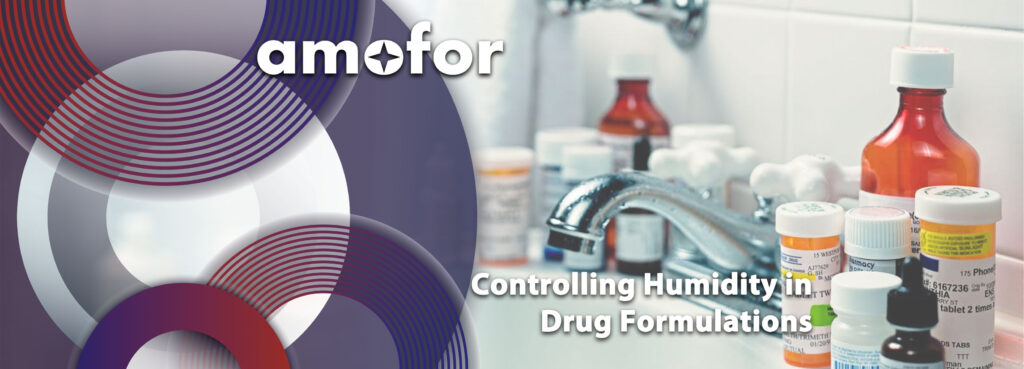Ensuring the stability and efficacy of drug formulations is of utmost importance. One often overlooked factor is storage humidity. Moisture uptake can significantly affect both the efficacy and the shelf life of drug formulations, especially that of amorphous formulations.
The Dual Challenge of Humidity in Amorphous Drug Formulations
Consider the all-too-common practice of storing medications in a bathroom. This environment, characterized by high temperatures and humidity, is detrimental to medication stability. Here’s why:
- Increased water absorption in amorphous formulations: Formulations lacking a defined crystalline structure, known as amorphous formulations, tend to absorb more moisture than crystalline ones. For example, at 75% relative humidity, such a formulation might see up to a 20% increase in water content, leading to destabilization and reduced effectiveness.
- Abrupt phase change and crystallization phenomena: Moisture can not only enhance the water level in the formulation, but also trigger the sudden crystallization of amorphous drugs, which is equivalent to a complete structural failure of the formulation. This usually results in diminished bioavailability and efficacy.
Understanding these challenges is critical, particularly in light of stringent guidelines set by regulatory agencies like the FDA and EMA. These guidelines are designed to ensure medications can withstand specific temperature and humidity conditions, which act as stress tests that mirror the drugs’ eventual real-world storage environments, safeguarding their stability and efficacy. The assertion that increased humidities merely result in the expedited progression of phenomena, such as using 6 months at 40°C/75%RH as an accelerated storage condition compared to 12 months at ambient storage conditions of 25°C/60% RH, is entirely incorrect, as thermodynamic equilibria yield entirely distinct outcomes.
The Power of Thermodynamic Modeling to Mitigate Humidity-Related Risks
To combat the risks associated with poor moisture control, it is not enough to simply recommend storing formulations below critical moisture levels. In practice, as moisture is omnipresent on earth, formulations are inevitably exposed to humid conditions during manufacture, storage and transportation, so it is critical to control the effects of moisture at every level.
This is where amofor’s thermodynamic modeling approach becomes indispensable. WE provide a powerful tool in forecasting and understanding moisture-induced transformations in amorphous drug formulations.This method enables to calculate the impact of specific humidity levels on formulations, even with limited data sets. By analyzing the correlation between relative humidity and the (intermolecular interaction specific) thermodynamic activity of water in the formulation, we can predict moisture penetration and its destabilizing effects, such as the changes caused by 5% or 10% water content.
For instance, we can accurately forecast the stability of a drug stored at 40°C and 75% humidity, a standard condition for accelerated stability testing (or any other stability condition as well). With this information, formulators can optimize the polymer selection or drug load of the formulation, evaluate the influence of different excipients, and determine the best packaging options for moisture protection.
Validated Approach: Collaboration and Extensive Testing
In the recent years, we have carried out extensive tests with our thermodynamic modeling strategy on up to 1,500 different formulations under different storage conditions. By aligning these model predictions with actual stability results, we have created a comprehensive and robust dataset, significantly enhancing our confidence in the model’s precision and reliability.
A practical example of this approach’s efficacy are our collaborations with leading pharmaceutical companies. In such projects, we evaluate multiple formulations under diverse conditions, focusing on quantifying moisture content, assessing crystallization velocity, and determining if formulations crystallize as predicted. The accuracy of our predictions was confirmed, demonstrating the practical utility of our thermodynamic modeling in real-world scenarios.
For detailed insights into some of our case studies, please refer to our peer-reviewed publications:
- Luebbert, C.; Sadowski, G. (2017): Moisture-induced phase separation and recrystallization in amorphous solid dispersions. Int. J. Pharm. 532 (1), S. 635–646. DOI: 1016/j.ijpharm.2017.08.121
- Lehmkemper, ; Kyeremateng, S. O.; Heinzerling, O.; Degenhardt, M.; Sadowski, G. (2017): Long-Term Physical Stability of PVP- and PVPVA-Amorphous Solid Dispersions. Mol. Pharmaceutics 14 (1), S. 157–171. DOI: 10.1021/acs.molpharmaceut.6b00763
- Grönniger, B.; Kimpe, K.; Singh, A.; Sadowski, G. (2024): Simultaneous Water Sorption and Crystallization in ASDs 1: Stability Studies Lasting for Two Years. Molecular pharmaceutics. DOI: 1021/acs.molpharmaceut.3c01056
Client-Centric Solutions to Increase Speed to Market
Our approach is not uniform; it’s customized. We collaborate closely with clients, understanding their unique challenges and providing tailored solutions. This strategy not only ensures the optimal performance of formulations under varied humidity conditions but also accelerates the speed to market.
Mastering moisture in drug formulation is a complex yet critical task. It’s not merely about avoiding water but involves a comprehensive understanding of its omnipresence and its impact on every aspect of drug manufacturing and storage. By leveraging thermodynamic modeling, strategic use of excipients, and innovative packaging solutions, you can ensure drugs deliver their intended therapeutic benefits effectively and reliably.
Control over moisture isn’t just a goal; it’s an inevitable necessity for the successful journey of a drug from the lab to the patient.
Connect with us if you want to learn how to avoid the bathroom effect in your current formulation!

